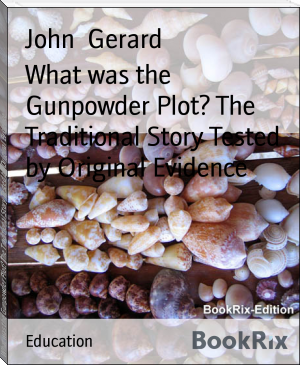What was the Gunpowder Plot? The Traditional Story Tested by Original Evidence by John Gerard (top 10 most read books in the world .TXT) 📕

- Author: John Gerard
Book online «What was the Gunpowder Plot? The Traditional Story Tested by Original Evidence by John Gerard (top 10 most read books in the world .TXT) 📕». Author John Gerard
Many curious circumstances have likewise been imported into the history, and many places connected with it which appear to have no claim whatever to such a distinction.
Thus we hear (England's Warning Peece) that the Jesuit Cresswell came over from Spain for the occasion "to bear his part with the rest of his society in a victorial song of thanksgiving." Also that on November 5th, a large body of confederates assembled at Hampstead to see the House of Parliament go up in the air.
In the Gentleman's Magazine, February, 1783, is a remarkable description of a summer house, in a garden at Newton Hall, near Kettering, Northamptonshire, in which the plotters used to meet and conspire, the place then belonging to the Treshams; "and for greater security, they placed a conspirator at each window, Guy Faukes, the arch villain, standing in the doorway, to prevent anybody overhearing them."
According to a wide-spread belief Guy Faukes was a Spaniard.[461] He has also been called a Londoner, and his name being altered to Vaux, has been said to have a family connection with Vauxhall. He was in fact a Yorkshireman of good family, though belonging to a younger branch of no great estate. His father, Edward Faukes, was a notary at York, where he held the office of registrar and advocate of the cathedral church. Guy himself was an educated man, more than commonly well read. He is always described in the process as "Guido Faukes, Gentleman."
Another most extraordinary example of an obvious myth, which was nevertheless treated as sober history, is furnished by the absurd statement that the astute and wily Jesuits not only contrived the Plot, but published its details to the world long before its attempted execution, in order to vindicate to themselves the credit of so glorious a design. Thus Bishop Kennet, in a fifth of November sermon, preached at St. Paul's before the Lord Mayor, in 1715, tells us:[462]
"It was a general surmise at least among the whole Order of Jesuits in foreign parts: or else one of them could hardly have stated the case so exactly some four or five years before it broke out. Father Del-Rio, in a treatise printed An. 1600, put the case, as if he had already looked into the Mine and Cellars, and had surveyed the barrels of powder in them, and had heard the whole confessions of Faux and Catesby."
This "general surmise" does not appear to have been confined to the Jesuits themselves. Another ingenious writer, nearly a century earlier,[463] tells a wonderful story concerning the sermon of a Dominican, preached in the same year, 1600, wherein it was related how there was a special hell, beneath the other, for Jesuits, so thick and fast did they arrive as to need extra accommodation. The preacher avowed that he had, in his vision of the place, given warning to the demon in charge of it, "to search them with speed, for fear that they had conveyed hither some gunpowder with them, for they are very skilfull in Mine-workes, and in blowing up of whole States and Parliament-houses, and if they can blow you all up, then the Spanyards will come and take your kingdom from you."
Another notable specimen of the way in which reason and probability were cast to the winds is afforded by two letters written from Naples in 1610, one to King James and the other to Salisbury, by Sir Edwin Rich,[464] who announced that Father Greenway--who of all the Jesuits was said to be most clearly convicted as a traitor--intended to send to the king a present of an embroidered satin doublet and hose, which, being craftily poisoned, would be death to him if he put them on.
FOOTNOTES:
[458] "And so by degrees to the uttermost."
[459] These instructions furnish an interesting specimen of the king's broad Scotch, e.g., "Quhat Gentlewomans Letter it was y^t was founde upon him, and quhairfor doth she give him an other Name in it y^n he giues to himself. If he was ever a papiste; and if so, quho brocht him up in it. If otherwayes, hou was he convertid, quhair, quhan, and by quhom."
The following passage is very characteristic of the writer:
"Nou last, ye remember of the crewellie villanouse pasquille y^t rayled upon me for y^e name of Brittanie. If I remember richt it spake something of harvest and prophecyed my destructi[=o] about y^t tyme. Ye may think of y^s, for it is lyke to be by y^e Laboure of such a desperate fellow as y^s is."
[460] The Arraignment and execution of the late traitors, etc., 1606.
[461] See, for instance, London and the Kingdom (mainly from the Guildhall Archives), by Reginald R. Sharpe, ii. 13.
[462] P. 9.
[463] Lewis Owen, Unmasking of all popish Monks, etc. (1628), p. 49.
[464] Dom. James I. lvii. 92-93, October 5th.
APPENDIX M.
Sir William Waad's Memorial Inscriptions.
IN a room of the Queen's House in the Tower, in which the conspirators are supposed to have been examined by the Lords of the Council, Sir William Waad has left a series of inscriptions as memorials of the events in which he played so large a part. Of these the most noteworthy are the following:
I.
Jacobus Magnus, Magnæ Britanniæ rex, pietate, justitia, prudentia, doctrina, fortitudine, clementia, ceterisq. virtutibus regiis clariss'; Christianæ fidei, salutis publicæ, pacis universalis propugnator, fautor auctor acerrimus, augustiss', auspicatiss'. Anna Regina Frederici 2. Danorum Regis invictiss' filia sereniss^a, Henricus princeps, naturæ ornamentis, doctrinæ præsidiis, gratiæ Muneribus, instructiss', nobis et natus et a deo datus, Carolus dux Eboracensis divina ad omnem virtutem indole,[465] Elizabetha utriusq. soror Germana, utroque parente dignissima Hos velut pupillam oculi tenellam providus muni, procul impiorum impetu alarum tuarum intrepidos conde sub umbra.
[This is evidently intended for a Sapphic stanza, but the last two words of v. 3 have been transposed, destroying the metre.]
II.
Robertus Cecil, Comes Sarisburiensis, summus et regis Secretarius, et Angliæ thesaurarius, clariss' patris et de repub. meritissimi filius, in paterna munera successor longe dignissimus; Henricus, comes Northamptoniæ, quinq. portuum præfectus et privati sigilli custos, disertorum litteratissimus, litteratorum disertissimus; Carolus comes Nottingamiæ, magnus Angliæ admirallus victoriosus; Thomas Suffolciæ comes, regis camerarius splendidissimus, tres viri nobilissimi ex antiqua Howardorum familia, ducumq. Norfolciæ prosapia; Edwardus Somersetus, comes Wigorniæ, equis regiis præfectus ornatissimus; Carolus Blunt, comes Devoniæ, Hyberniæ prorex et pacificator, Joannes Areskinus,[466] illustris Marriæ comes, præcipuarum in Scotia arcium præfectus; Georgius Humius, Dunbari comes, Scotiæ thesaurarius prudentiss' omnes illustriss' ordinis garteri milites; Joannes Popham, miles, justiciarius Angliæ capitalis, et justitiæ consultissimus:
Hi omnes illustrissimi viri, quorum nomina ad sempiternam eorum memoriam posteritati consecrandam proxime supra ad lineam posita sunt, ut regi a consiliis, ita ab eo delegati quæsitores, reis singulis incredibili diligentia ac cura sæpius appellatis, nec minore solertia et dexteritate pertentatis eorum animis, eos suis ipsorum inter se collatis responsionibus convictos, ad voluntariam confessionem adegerunt: et latentem nefarie conjurationis seriem, remq. omnem ut hactenus gesta et porro per eos gerenda esset, summa fide erutam, æterna cum laude sua, in lucem produxerunt, adeo ut divina singulari providentia effectum sit, ut tam præsens, tamq. f[oe]da tempestas, a regia majestate, liberisq. regiis, et omni regno depulsa, in ipsos autores eorumq. socios redundarit.
III.
Conjuratorum Nomina, ad perpetuam ipsorum infamiam et tantæ diritatis detestationem sempiternam.
Thomas Winter Thomas Percy Robert Winter Robert Catesby Monachi { Henry Garnet John Winter John Wright salutare { John Gerrard Guy Fawkes Christopher Wright Jesu { Oswald Tesmond Thomas Bates Francis Tresham nom[=e] { Ham[=o] Everard Digby, K. Thomas Abbington ementiti { Baldw[=i] Am' Rookewood Edmond Baineham, K. John Graunt William Stanley, K. Robert Keyes Hughe Owen. Henry Morg[=a]
IV.
Besides the above there is a prolix description of the Plot, devised against the best of sovereigns, "a Jesuitis Romanensibus, perfidiæ Catholicæ et impietatis viperinæ autoribus et assertoribus, aliisq. ejusdem amentiæ scelerisq. patratoribus et sociis susceptæ, et in ipso pestis derepente inferendæ articulo (salutis anno 1605, mensis Novembris die quinto), tam præter spem quam supra fidem mirifice et divinitus detectæ."
There is, moreover, a sentence in Hebrew, with Waad's cipher beneath, and a number of what seem to be meant for verses. The following lines are evidently the Lieutenant's description of his own office:
"Custodis Custos sum, Carcer Carceris, arcis Arx, atque Argu' Argus; sum speculæ specula; Sum vinclum in vinclis; compes cum compede, clav[=u] Firmo hærens, teneo tentus, habens habeor. Dum regi regnoq. salus stet firma quieta, Splendida sim Compes Compedis usque licet."
This is considerably more metrical and intelligible than some of the rest.
In 1613 Waad was dismissed from his post, one of the charges against him being that he had embezzled the jewels of Arabella Stuart.[467]
In Theobald's Memoirs of Sir Walter Raleigh (p. 16), Waad is described as "the Lieutenant of the Tower, and Cecil's great Creature."
FOOTNOTES:
[464] Dom. James I. lvii. 92-93, October 5th.
[465] At the time of the Plot Charles was not quite five years old.
[466] Erskine.
[467] Dom. James I. lxxii. 129.
APPENDIX N.THE PUBLISHED CONFESSION OF GUY FAUKES. A.
The draft, November 8th, 1605 (G.P.B. 49).
*** Passages between square brackets have been cancelled. Those marked * have been ticked off for omission.
The Confession of Guy Fawkes, taken the 8 of November, 1605.
HE confesseth that a Practise in generall was first broken unto him, agaynst his Majesty, for the Catholique cause, and not invented or propounded by himself, and this was first propounded unto him about Easter last was twelvemonth, beyond the seas in the Low countreyes, by an English Lay-man, and that English man came over with him in his company into England, and they tow and three more weare the first five mencioned in the former examination. And they five resolving to do some thinge for the Catholick cause,--a vowe being first taken by all of them for secrecye,--one of the other three propounded to perform it with Powder, and resolved that the place should be,--where this action should be performed and justice done,--in or neere the place of the sitting of the Parliament, wherein Religion had been uniustly suppressed. This beeinge resolved the manner [of it] was as followeth.





Comments (0)